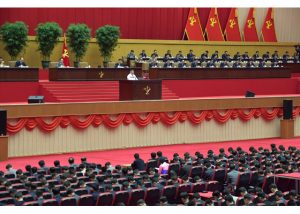“Worst-Ever Situation” or Not

Kim Jong Un’s references to the current situation during the Sixth Conference of Cell Secretaries of the Workers’ Party of Korea (WPK) held from April 6 to 8 sparked a flurry of foreign media speculation about the state of the North Korean economy, a subject that has been under heavy international scrutiny since the country initiated a national lockdown in January 2020 to try to prevent a domestic outbreak of COVID-19.
“Worst-Ever Situation”?
What first caught foreign media’s attention was Kim Jong Un’s use of “the worst-ever situation” in this part of his opening address, carried by North Korea’s English-language media outlets:
…improving the people’s living standards and in all other fields even in the worst-ever situation in which we have to overcome unprecedentedly numerous challenges…[1]
In the vernacular report, however, this term read kuknanhan (극난한), which would be better translated as “very hard” or even “extremely difficult.”[2] North Korea’s English-language media sometimes omit passages or provide translations that are different from the vernacular text, and without analyzing years’ worth of data, it is impossible to conclude whether they do so deliberately, or if they are simply oversights.
It is clear, however, that Kim did not say “the worst-ever situation” at this event. Even if he had, the North Korean leader has made similar remarks in connection with the country’s current circumstances in recent months. For example, Kim’s opening address at the Eighth Party Congress in January referred to the past five years as a period of “unprecedented, worst-ever trials.”[3]
Contextualizing “Arduous March”
Toward the end of his closing speech, Kim said:
…and to bring the maximum material and cultural well-being to our people, I have decided that party organizations at each level, starting with the party Central Committee, and cell secretaries across the entire party shall carry out a more difficult “Arduous March.”[4] (Emphasis added by author.)
The term “Arduous March” is associated with an extremely trying situation and hunger. It originated in the approximately 100-day march by Kim Il Sung and his anti-Japan guerrilla unit in the late 1930s. The most recent Arduous March refers to the mid to late 1990s, when millions of North Koreans died from widespread hunger. The “spirit of the Arduous March” was announced in the 1996 New Year’s joint editorial by the party, army and Youth League dailies, North Korea’s most important policy document of the year.[5] North Korean state media articles regularly mention “Arduous March,” typically to recall the spirit with which the people tided over difficulties in the 1990s. On the other hand, this terminology has been attributed much less frequently to the leader. According to the ROK Ministry of Unification, Kim Jong Un has previously mentioned “Arduous March” in only three public speeches, all in historical contexts, unlike at the latest cell secretaries’ meeting.[6]
There is no evidence to suggest that North Korea’s economic situation is nearly as dire as the Arduous March of the 1990s. Unlike in 1996, Kim’s brief announcement of “Arduous March” at the party cell secretaries’ meeting was not presented as a policy guideline for the year. Choson Sinbo, a website operated by the General Association of Korean Residents in Japan (Chongryon), claimed that the term “Arduous March” was not synonymous with economic difficulties but rather reflected a “life-and-death” resolve to carry out the decisions reached at the January Party Congress.[7] The article also pointed out that Kim’s use of the term was confined to the Workers’ Party this time, not the entire population as was the case in the past. Choson Sinbo appears to have editorial ties to Pyongyang and regularly publishes commentary on issues that North Korea itself seems reluctant to discuss.
How North Korea follows up on “Arduous March” will shed better light on the country’s circumstances and Kim’s intention for bringing up the term. As of April 14, North Korea’s print media has not mentioned this formulation again.
- [1]
“Opening Speech Made by Respected Comrade Kim Jong Un at Sixth Conference of Cell Secretaries of WPK,” Rodong Sinmun, April 7, 2021, http://rodong.rep.kp/en/index.php?strPageID=SF01_02_01&newsID=2021-04-07-0002.
- [2]
Translated from: “조선로동당 제6차 세포비서대회에서 한 개회사 김정은,” Rodong Sinmun, April 7, 2021, http://rodong.rep.kp/ko/index.php?strPageID=SF01_02_01&newsID=2021-04-07-0001.
- [3]
“Supreme Leader Kim Jong Un Makes Opening Speech at 8th WPK Congress,” Rodong Sinmun, January 6, 2021, http://rodong.rep.kp/en/index.php?strPageID=SF01_02_01&newsID=2021-01-06-0007.
- [4]
Translated from: “조선로동당 제6차 세포비서대회에서 한 페회사 김정은,” Rodong Sinmun, April 9, 2021, http://rodong.rep.kp/ko/index.php?strPageID=SF01_02_01&newsID=2021-04-09-0002.
- [5]
The joint editorial said: “Today, when serious tasks arise before the party and the revolution, our party calls on all party members, People’s Army officers and men, and the people to live and fight with the spirit of the ‘Arduous March’ created in the thick forests of Mt. Paektu.” See: “붉은기를 높이 들고 새해의 진군을 힘차게 다그쳐나가자,” Rodong Sinmun, January 1, 1996, pp. 1-2.
- [6]
These speeches were made at a national light industry meeting in 2013, a national war veterans meeting in 2015, and at the Seventh Party Congress in 2016. See: “통일부 “北김정은 ‘고난의 행군’ 첫 언급”…이후 “아니다” 정정(종합2보),” News1, April 9, 2021, https://m.news1.kr/articles/?4269865&189.
- [7]
Translated from: “《고난의 행군》결심이 예고하는 거세찬 공격전,” Choson Sinbo, April 14, 2021, https://www.chosonsinbo.com/2021/04/15-50/.
